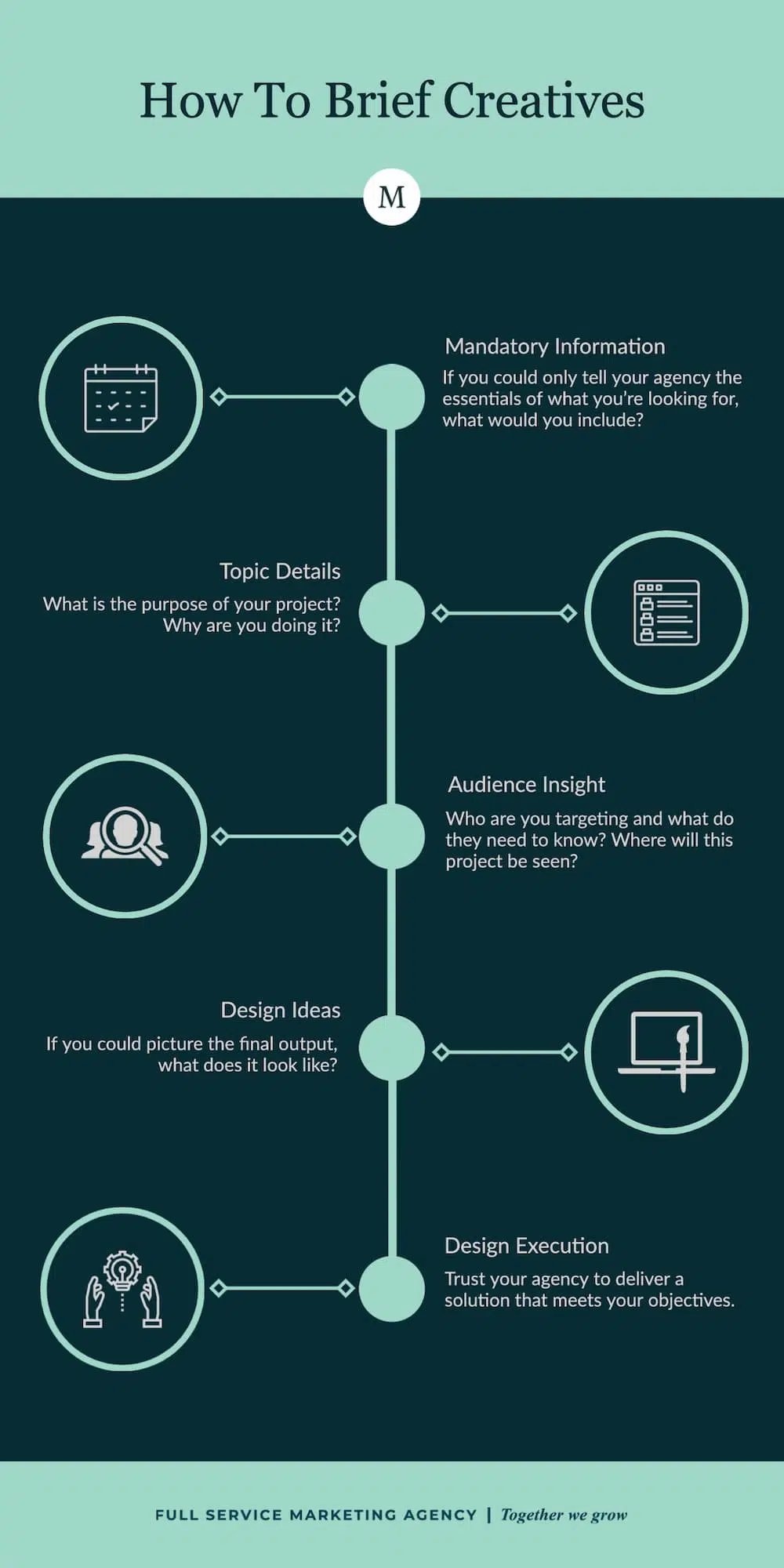For any business, engaging the services of an agency to deliver a creative solution can be a big step. The partnership between agency and client works at its best when both parties are clear on what they need to provide. In order to attain an end product that meets your expectations, a detailed brief is essential. As the client, specifying your requirements in as much detail as you can will give your agency everything they need before they put pen to paper. Nobody wants to feel like they are communicating back and forth with no end goal in sight. So, how can you write a brief that tells your designer exactly what they need to know?
What is an agency brief?
An effective brief is one that has a clear idea and gives an obvious direction to the design process. A simple analogy to use is one of a construction site. To give the project clear parameters for success, everybody needs to be working from the same blueprints, with the correct tools for the job. This is why a detailed brief is so important, and will ultimately save you time and money in the long run and ensure optimal return on your investment.

Key questions to answer in a brief
Why are you doing it?
Coming to an agency with realistic expectations is key. In an ideal world, for example, your ecommerce website would be a competitor with huge multinational players such as Amazon. However, investing millions of pounds into a website solution is out of the realms of possibility for the vast majority of businesses, especially small to medium sized enterprises. As a result, you must communicate the aims of the project to your agency clearly and succinctly. In essence, what was the trigger for you to get in touch with an agency, and why do you need their services?
Who are you doing it for?
Understanding your audience is key when you are looking to brief in work to an agency. At Mackman, we conduct audience insight as part of our branding projects to ensure that our solutions are crafted with your customers in mind. However, coming to an agency with an initial idea of the audiences who will be using and interacting with the solution you have commissioned is a vital part of the briefing process.
What does success look like?
Define your objectives for the solution you are looking for – how will it benefit your business? Specific metrics are not always necessary, but having a clear idea of how you want the end product to perform is perhaps the most important part of a brief. In the example of a website, what is the purpose that you want it to perform? Are you looking for a platform to drive traffic towards in order to generate leads? Does your website need to provide a virtual business card that you can refer clients towards? Does it need event booking functionality or a product catalogue for online shopping?
So, how do you brief an agency?
You need to provide as much clarity as you can. Although agencies can often provide support in establishing areas such as your objectives and specifics relating to the nature of the solution, this can incur extra time and money. By approaching an agency with a clear idea of what you are looking to achieve, you are maximising your chances of success and minimising the potential for any misunderstandings as the project gets underway.
Most problems with briefs occur as a result of poor communication and a lack of information. Providing too much information is far better than providing too little, and ensuring you are prepared when the key questions above are posed to you will establish a positive working relationship from the outset.
The components you should include in your design brief are:
Mandatory Information
These are the fundamental facts about your project. You should include the most important information at the front and centre of your brief, such as the core aims of the project and the final due date. Especially regarding design, you should provide information on the type of solution you are looking for, and where this will be used. For example, is it for a print or digital medium? This is also where you would include any legal information or disclaimers such as restrictions on offer validity for a promotional advert. It is essential for your agency to know this information if it will impact the scope or the output of the project.
Topic Details
You should be as clear as possible with what your end goal is. You should explain what the product or occasion is that you need the agency’s support with. You should also indicate the purpose of the design or project and the goal it has to accomplish. Is it to inform, promote, or entertain? On a strategic level, this will allow the agency to understand the potential solutions, and can even start to inform the themes and branding that will be needed as part of the project. For example, if you are looking to run a social media campaign for a Spring sale, providing specific information on the potential tone, audiences, channels and key messaging will provide background detail to the agency that can promote idea and concept generation.
Audience Insight
It is essential to provide information about your audience when briefing the agency. This can be broad at the beginning of the project, as previously mentioned, as full service marketing agencies will offer more in-depth analysis of your audience to avoid a generic solution that risks missing your key audience groups.
This information is all about your audience: who are they, where do you find them, what are their needs, and how do you communicate with them? Try to indicate anything that will resonate with your audience here, and detail what they need to take away.
Project Ideas
Any ideas you can put forward will be helpful as it can give your agency a vision of what direction you are hoping the project to take. However, it is also important to have realistic expectations here, taking into account the budget of your project, and the capabilities of the agency. This does not need to be as granular as specific suggestions like typography. Forming an attachment to these small elements can lead to disappointment when an agency offers alternative solutions using their own expertise to produce something that will work for your stated aims. Knowing that you have handed over all the information you can, trust your agency to deliver a solution that you are happy with. If you have ideas about how you want to share your message, or any industry insight that will enhance the efficacy of the project, it is worth including as part of the brief.
Summary
Developing a clear and detailed brief will create a positive working relationship with your agency that informs them of exactly what you are looking to achieve. This increases the likelihood that you will receive an end product that meets with your expectations, and also provides both parties with a document to refer to throughout the project that contains the key information that forms the foundations of your creative solution.
These guidelines provide a framework for points to consider when you are writing up a brief. However, if you are looking for some more guidance on how to brief a creative agency, it is always best to ask, as requirements may differ from designer to designer. Take a look at our marketing strategy services, or get in touch with one of our friendly team at Mackman by emailing customerservice@mackman.co.uk or calling 01787 388038.
Are you looking for a visual guide covering how to brief a creative agency that you can print out and refer to? Download our agency briefing process graphic below.
